
By Lara Atwood
Today, the predominant view of God in the Western world and in many other cultures is as a male.
Although supreme deities are sometimes portrayed as having feminine attributes and as being genderless, there has been an obvious bias toward masculinity. This has many consequences, intended or otherwise, in the understanding of the female aspect of creation and women’s place in the world.
Looking back through history, is it any wonder that male dominated religions have also created male dominated societies? That women were restricted from entering temples, from being instructed in spirituality, from holding positions of authority in religion, and even having a right to speak and hold authority in society?
Contents
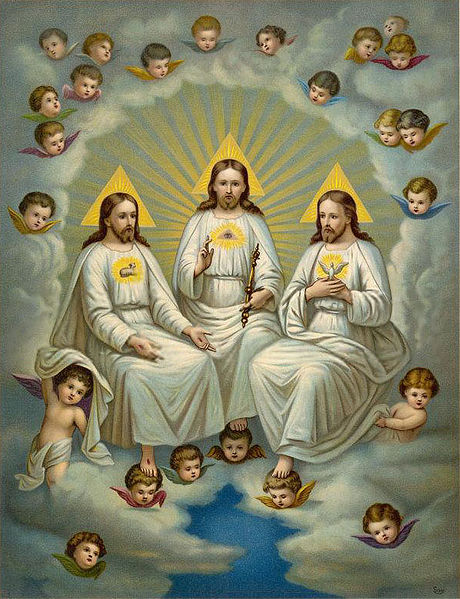
Does something look not quite right here? Creation without a female? The Holy Trinity is often depicted as three men.
This injustice in Christian societies is actually the result of a massive cover up, which has come to light as more and more early Christian texts have been discovered over approximately the last 200 years revealing that women were treated by Jesus as being equally important as men in society and religion, and that the feminine is part of God, just as the masculine is. This same understanding existed in the sacred texts of the ancient Egyptians, Chinese, Vedic scriptures, and in the mythologies of the Mayans and old pagan religions of Europe amongst many others.
But what have we been missing out on? The feminine is an incredible part of life—she exists throughout the cosmos, and in our own inner nature. She is the essential half of the polarity that exists throughout the entirety of creation. Jesus taught about the feminine as part of Godhead, but these teachings were excluded from the Bible. Instead the common concept of God and of women in society has been based on the ideas of powerful groups of men who created and sustained male dominated societies for thousands of years which Western culture inherited through orthodox religions.
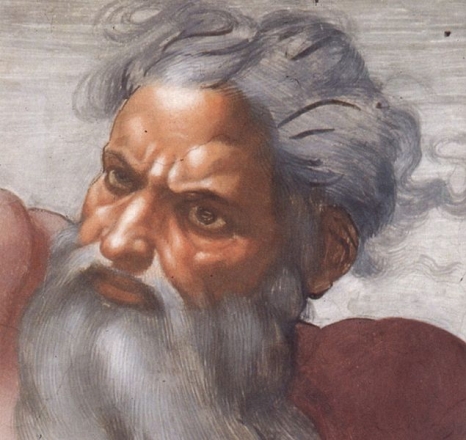
The archetypal view of God in Western culture.
Western nations were founded and have developed through the influence of the Christian religion over almost two thousand years. The affect of this cannot be ignored. Whilst spiritual beliefs in Western culture have appeared to shift toward atheism, multiculturalism and the new age, Christianity remains a dominant force, and the institutions and structures of society which formed through Christianity still largely remain today.
The basis of Christian doctrine is the Bible which is comprised mostly of texts that enumerate a male dominated world view and refer to Godhead as being male. Although viewed by many as a book about Jesus, his words comprise a tiny amount of its actual volume, which consists mostly of the Old Testament (a collection of Judaic texts) and material by Paul. What we have as the Bible today formed over a number of centuries as a compilation of various texts put together by men in completely male dominated societies. Irenaeus, the 2nd century Church Father who penned the work Against Heresies that attacked the followers of Jesus’ secret and esoteric teachings, cited 21 books that would eventually officially end up as part of the New Testament, and by the second century AD most of the writings that formed the New Testament were accepted by almost all major Christian authorities.
Scores of other texts which emerged from the teachings of Jesus and his disciples were banned, burned, and buried in a campaign of suppression against the real message of Jesus. Instead, much of the Bible was based on Jewish society which discriminated against women, and Paul in his writings perpetuated their inferior treatment.
From the Ontario Consultants on Religious Tolerance:
Women in ancient Israel:
Women’s status and freedoms were severely limited by Jewish law and custom in ancient Israel, as they were in essentially all other cultures at the time. Generally speaking:
- most were restricted to roles of little or no authority,
- they were largely confined to their father’s or husband’s home,
- they were considered to be inferior to men, and under the authority of men — either their father before marriage, or their husband afterwards.
From the Second Temple period, women were not allowed to testify in court trials. They could not go out in public, or talk to strangers. When outside of their homes, they were to be doubly veiled. “They had become second-class Jews, excluded from the worship and teaching of God, with status scarcely above that of slaves.” 1 Their position in society was defined in the Hebrew Scriptures and in the interpretation of those scriptures. More details.
Godhead in Christianity Gains Ground as Being All Male at The Council of Nicaea
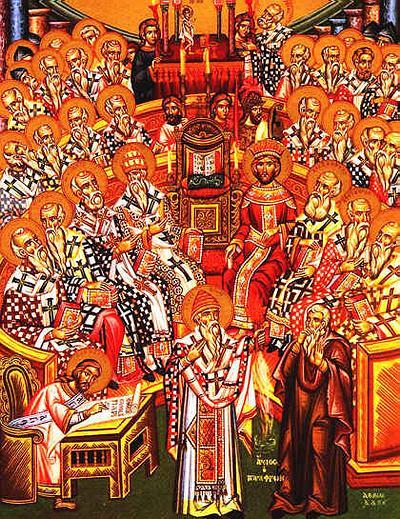
A depiction of the Council of Nicaea – no women attended.
Later, at The Council of Nicaea in 325 AD, the exclusion of the feminine from Godhead was solidified. The council was a convention of Christian male bishops brought together by Constantine, the Emperor of Rome who converted to Christianity. It was a turning point in Western culture, as it was instrumental in defining the Christian religion as we know it today and cementing its dominance in the Western world. Christianity eventually became the official religion of Rome in 380 AD, and this union between Church and State formed the basis of Roman society which consequently exetered powerful influences over the cultural development of the West. Today, the Roman Catholic Church is still the largest Christian church in the world, with over 1 billion members.
It was here that the idea of a male only Godhead really gained ground (later to become fully defined as the Trinity at the Council of Constantinople in 360 AD) as the relationship between the Son and the Father was decreed. The Council had two arguments about how the Son had been created. One was that he was begotten by the Father from his own being, and the other that he was created as all creatures, out of nothing. Both ignored the role of the cosmic Mother in the process of creation—completely at odds with the principles of the natural world. In the end it was decided that the first argument was correct, and thus Christianity was left with the view that the Father created the Son from his Holy Spirit, with Mary as its human instrument.
The Holy Spirit as Female?
Since 360 AD, Godhead in the Christian religion has officially been seen as the Trinity comprising of three aspects of God, being Father, Son, and Holy Spirit. These aspects were interpreted as belonging to the one being which was predominantly viewed as male, and thus were referred to with the male pronoun HE in the Bible. But how much of this could be due to male dominated social attitudes combined with interpretations during translation?
The four gospels of the Bible were discovered in Greek, whereas most believe that Jesus spoke in Aramaic. Is it possible that Jesus intended the Holy Spirit to represent the female aspect of creation, as the word spirit in Aramaic is feminine?
As support for this, there were many other early Christian texts that were excluded from the Bible even though they were also attributed to the disciples and contained the teachings of Jesus. In texts such as the Pistis Sophia, The Acts of Thomas and The Gospel of Phillip, the Holy Spirit is identified with the great Mother (as explored further below). Additionally, they contain clear references to the Mother as part of Godhead, along with the Father and Son.
[…] we glorify and praise thee and thine invisible Father and thine holy spirit [and] the mother of all creation.
~ The Acts of Thomas, translated by M. R. James
Some said, “Mary conceived by the Holy Spirit.” They are in error. They do not know what they are saying. When did a woman ever conceive by a woman?
~ The Gospel of Phillip, The Nag Hammadi Library, translated by Wesley W. Isenberg
The Holy Spirit was also referred to as female in another text also not included in the Bible, called The Wisdom of Solomon, and dated to the first century BC. In this text the female is identified as wisdom and the feminine aspect of Godhead.
In yet another text attributed to Solomon and left out of the Bible, called The Odes of Solomon, and recorded as being studied by the disciples themselves, the Holy Spirit is also very clearly identified as female.
The Son is the cup, and the Father is He who was milked; and the Holy Spirit is She who milked Him…
~ The Odes of Solomon, translated by James H. Charlesworth
The dove fluttered over the head of our Lord Messiah, because He was her head. And she sang over Him, and her voice was heard.
~ The Odes of Solomon, translated by James H. CharlesworthI rested on the Spirit of the Lord, and She lifted me up to heaven.
~ The Odes of Solomon, translated by James H. Charlesworth
References to the Holy Spirit as the Mother are numerous and have surfaced in multiple, and separate discoveries – many of which are attributed to Jesus and the disciples themselves. Therefore, it looks very likely that the Holy Spirit was initially used as a term to describe the Mother, but later to replace references to her completely in the few texts left remaining in the Bible, and was “reinterpreted” by councils of men as being male. And thus the all male Trinity became firmly established in mainstream Christianity.
Texts Referring to Female as Part of Godhead Excluded from the Bible

Mary as mother of Jesus is crowned, but seated safely below all the male aspects of Godhead. Concepts of Mother Goddess worship are condemned by the Holy See.
Is it any coincidence that all of the texts containing any references to the female as part of Godhead were excluded from the Bible? Instead, the Bible is comprised almost entirely of the Old Testament (a collection of Judaic works) and material by Paul, with only a comparatively tiny number of select teachings by Jesus. To think of orthodox Christianity as the religion of Jesus and the disciples is misguided and misplaced. It ignores the history of the formation of the Christian religion, which was shaped by the hands of men who had never met and had nothing to do with Jesus.
The Judaic religion had formed the basis of the male dominated society which Jesus came into, and was based on a monotheistic God manifest predominantly as male. This society continued, and so it appears that most of the books of early Christianity which were esoteric and did not align to this tradition, were actually banned and excluded from the Bible.
The Gospel of Mary was such a text; it reveals a very different view of women than the texts of Paul—likely being one of the reasons it was left out. The four gospels themselves are also very likely to have been tampered with, leaving only what was seen as acceptable to the bishops and rulers meeting behind closed doors.
Whilst the Christian Mary (the mother of Jesus) is seen as divine and having a sacred role of giving birth, the important difference is that she is not included in Godhead, but is its instrument. Mary Magdalene, Jesus’ most famous female disciple, was later depicted by the church as a repentant prostitute, whilst no references in the Bible to her being a prostitute exist. This understanding of women infiltrated not only the perception of divinity, but also the very structure of Western society.
Paul Perpetuates Society’s View on Women
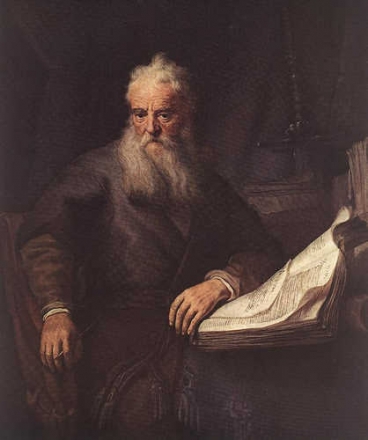
A rendition of Paul writing. Perhaps having no contact with Jesus, nor the disciples who were in disagreement with him, Paul was never exposed to Jesus’ view on women and just perpetuated the male dominated social view of the time.
Society and religion at the time of Jesus was already completely male dominated, and there were influences that wanted to keep it that way. As we will see further below, the actual teachings of Jesus about the feminine aspect of God were suppressed and kept out of the Bible. Instead, the teachings of Paul, who never met Jesus and was not one of his disciples, were piled into the New Testament.
Much of the basis that formed the understanding of gender roles in Western culture actually stems from the writings of Paul who perpetuated the already entrenched male dominated society. In the texts of the New Testament, Paul makes statements which need little introduction, such as:
“But I would have you know, that the head of every man is Christ; and the head of the woman is the man; and the head of Christ is God.”
Paul ~ I Corinthians 11:3 KJV“For the man is not of the woman; but the woman of the man. Neither was the man created for the woman; but the woman for the man.”
Paul ~ I Corinthians 11:8-9 KJV“Let the woman learn in silence with all subjection. But I suffer not a woman to teach, nor to usurp authority over the man, but to be in silence. For Adam was first formed, then Eve. And Adam was not deceived, but the woman being deceived was in the transgression.”
Paul ~ I Timothy 2:11-14 KJV“Wives, submit yourselves unto your own husbands, as unto the Lord. For the husband is the head of the wife, even as Christ is the head of the church: and he is the saviour of the body. Therefore as the church is subject unto Christ, so let the wives be to their own husbands in every thing.”
Paul ~ Ephesians 5:22-24 KJV“Let your women keep silence in the churches: for it is not permitted unto them to speak; but they are commanded to be under obedience, as also saith the law. And if they will learn any thing, let them ask their husbands at home: for it is a shame for women to speak in the church.”
Paul ~ I Corinthians 14:34-35 KJV
These are some examples. The words of Paul came to have such a powerful influence over Western society as the Bible ends with the following statement:
For I testify unto every man that heareth the words of the prophecy of this book, If any man shall add unto these things, God shall add unto him the plagues that are written in this book: And if any man shall take away from the words of the book of this prophecy, God shall take away his part out of the book of life, and out of the holy city, and from the things which are written in this book. He which testifieth these things saith, Surely I come quickly. Amen. Even so, come, Lord Jesus. The grace of our Lord Jesus Christ be with you all. Amen.
~ Revelation 22:18-21 KJV
This statement has been interpreted as saying that the Bible in its entirety it is the infallible word of God. Therefore, this effectively gave Paul and the writings of the Old Testament the same authority as the words of Jesus. What position did that leave women in? They were faced with arguing against the supposed word of God himself or worse, to be seen as blasphemous for violating it. But the book of Revelation was never written as part of the Bible; it was a separate text that originally wasn’t even included, and therefore the reference at the end refers to the book of Revelation itself and not to the entire Bible.
Jesus on Women in the Bible
Instead, in the few words left of Jesus we have left in the Bible, he shows equality toward women—something revolutionary at a time when society only gave women restricted access to the Temple of Jerusalem, were not be spoken to by men who were not their husband in public nor instructed in matters of theology by a Rabbi, and were generally prohibited from taking roles of authority.
Jesus had women disciples and was supported financially by women. Here Wikipedia gives a very good overview of Jesus’ interactions with women in the four gospels and the Ontario Consultants on Religious Intolerance give another on the radical treatment of women by Jesus .
Following are just two examples from the Bible of Jesus teaching women in their own right.
Jesus Talks to the Samaritan Woman
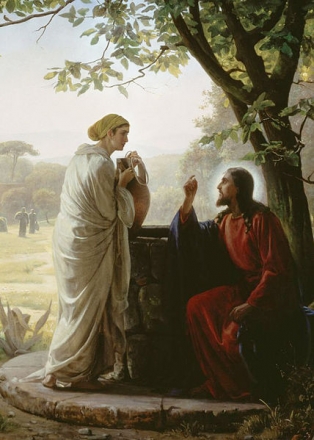
Jesus stops to talk to the Samaritan woman, despite the social rules of the day.
Jesus stops and talks to a Samaritan woman – when talking to a Samaritan, let alone a woman, was against social custom:
The woman said, “I know that Messiah” (called Christ) “is coming. When he comes, he will explain everything to us.” Then Jesus declared, “I, the one speaking to you—I am he.” Just then his disciples returned and were surprised to find him talking with a woman. But no one asked, “What do you want?” or “Why are you talking with her?”
~ The Gospel of John 4:25-27 NIV
Mary Leaves Her Work in the Home to Listen to Jesus
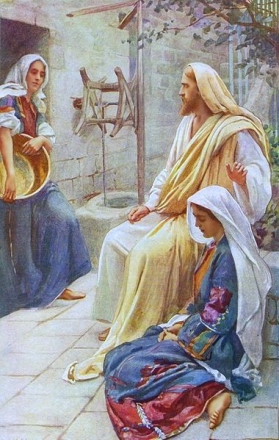
Martha tries to pressure Mary into helping her in the kitchen, but Jesus says she can and should stay to listen to his spiritual teaching which was more important.
Below Jesus tells Martha that Mary has made the right choice to receive his spiritual teaching rather than work in the kitchen:
As Jesus and his disciples were on their way, he came to a village where a woman named Martha opened her home to him. She had a sister called Mary, who sat at the Lord’s feet listening to what he said. But Martha was distracted by all the preparations that had to be made. She came to him and asked, “Lord, don’t you care that my sister has left me to do the work by myself? Tell her to help me!” “Martha, Martha,” the Lord answered, “you are worried and upset about many things, but few things are needed—or indeed only one. Mary has chosen what is better, and it will not be taken away from her.”
~ Luke 10:38-42 NIV
However, despite Jesus’ stance of equality toward women, there is no clear reference to any feminine force in Godhead in the Bible. But it’s unclear just how much the words of Jesus themselves were tampered with to take it out. A number of early Christian texts that have surfaced reveal more about Jesus and the disciples’ views towards women—these are The Essene Gospel of Peace, The Gospel of Mary, The Acts of Thomas, The Gospel of Phillip, Pistis Sophia, The Gospel of Thomas, The Gospel of the Egyptians, The Odes of Solomon, and probably many others.
Jesus Describes the Mother in The Essene Gospel of Peace
The Essene Gospel of Peace is an early Christian text containing teachings of Jesus, which a man called Edmund Bordeaux Szekely claimed to have discovered in 1923 whilst researching in the Vatican Library. He later produced and released its translation. Although written off as a hoax by many, Jesus was said to have spent time with the community of the Essenes, and the authenticity of much of its spiritual message is impossible to ignore. It is also highly likely that the Vatican Library contains a cache of the esoteric texts it confiscated and banned as heresy, and that The Essene Gospel of Peace may be just one of many. Mr Szekely himself claims he saw other Gospels by the disciples, writings of Simon Magus, and further writings of the Essenes among others, which were locked in the archives and have never been publicly released.
It’s possible that The Essene Gospel of Peace is a collection of different texts compiled together as one document to spread and protect them from destruction by the church authorities.It is hard to say whether or not it too has been partially tampered with as it incorporates fragments that also appear in the New Testament, indicating that it may not be the word-for-word verbatim of Jesus, but was written down based on his teachings and pulled together from various sources—some perhaps more reliable than others. Even so, it does give us a glimpse of the magnitude of the teachings Jesus gave about the feminine aspect of the creator that were stripped out of the Bible and banned.
The Essene Gospel of Peace refers to Father, Mother and Son as the three aspects of Godhead, fully recognizing the feminine force of creation as part of the Trinity.
FOR YOUR HEAVENLY FATHER IS LOVE.
FOR YOUR EARTHLY MOTHER IS LOVE.
FOR THE SON OF MAN IS LOVE.
It is by love, that the Heavenly Father and the Earthly Mother and the Son of Man become one.
~ The Essene Gospel of Peace, translated by Edmund Bordeaux SzekelyI tell you truly, you are one with the Earthly Mother; she is in you, and you in her. Of her were you born, in her do you live, and to her shall you return again.
~ The Essene Gospel of Peace, translated by Edmund Bordeaux SzekelyFor-I tell you truly, from one Mother proceeds all that lives upon the earth. Therefore, he who kills, kills his brother. And from him will the Earthly Mother turn away, and will pluck from him her quickening breasts.
~ The Essene Gospel of Peace, translated by Edmund Bordeaux SzekelyAnd just as the roots of the tree
Sink into the earth and are nourished,
And the branches of the tree
Raise their arms to heaven,
So is man like the trunk of the tree,
With his roots deep
In the breast of his Earthly Mother,
And his soul ascending
To the bright stars of his Heavenly Father.
And the roots of the tree
Are the Angels of the Earthly Mother,
And the branches of the tree
Are the Angels of the Heavenly Father.
And this is the sacred Tree of Life
Which stands in the Sea of Eternity.
~ The Essene Gospel of Peace, translated by Edmund Bordeaux Szekely
Whilst the writings of Paul in the Bible dogmatically set out rules for the behavior of women and their place in the divine hierarchy, The Essene Gospel of Peace speaks about a completely different way of understanding—which says that understanding is not gained through reading the scriptures that are created by men, but through self-knowledge and the living perception of the principles of creation in which the feminine plays an essential role.
In everything that is life is the law written. You find it in the grass, in the tree, in the river, in the mountain, in the birds of heaven, in the fishes of the sea; but seek it chiefly in yourselves. For I tell you truly, all living things are nearer to God than the scripture which is without life. God so made life and all living things that they might by the everlasting word teach the laws of the true God to man. God wrote not the laws in the pages of books, but in your heart and in your spirit. They are in your breath, your blood, your bone; in your flesh, your bowels, your eyes, your ears, and in every little part of your body. They are present in the air, in the water, in the earth, in the plants, in the sunbeams, in the depths and in the heights. They all speak to you that you may understand the tongue and the will of the living God. But you shut your eyes that you may not see, and you shut your ears that you may not hear. I tell you truly, that the scripture is the work of man, but life and all its hosts are the work of our God. Wherefore do you not listen to the words of God which are written in His works? And wherefore do you study the dead scriptures which are the work of the hands of men?
~ The Essene Gospel of Peace, translated by Edmund Bordeaux Szekely
In the natural world creation can only take place with the cooperation of male and female. Neither one can create without the other, nor would either exist without each other. The view of a male only God flies not only in the face of our understanding of the natural world, but also in the face of some of the most ancient accounts of creation in sacred Egyptian, Vedic, and Mesoamerican sources, and even in the words of Jesus himself.
Women in The Gospel of Mary
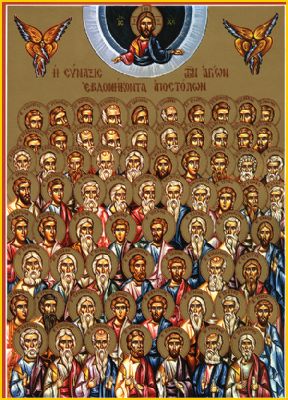
The supposed 70 apostles of Jesus. Hmm, no women in here… Perhaps they overlooked the references to Jesus having women disciples?
The Gospel of Mary is an early Christian text that has been ascribed to Mary Magdalene, and surfaced in 1896. In it, Mary emerges as holding a high status amongst the apostles, and receives secret teachings from Jesus which she reveals to the disciples. However, she meets with disapproval from Peter because she is a woman.
Levi admonishes Peter for potentially excluding women, as Jesus had told the disciples not to create any further laws than the ones he gave, and nowhere had Jesus made any laws regarding the discrimination against sexes (or others concerning race, class etc.). This creation of further laws apart from the ones Jesus gave was a mistake that Paul later made, and which resulted in a distortion of Jesus’ message. This is how much of the dogma regarding the role of women in Western society was created, where in reality in Jesus’ actual teachings it simply doesn’t exist.
Peter also opposed her [Mary Magdalene] in regard to these matters and asked them about the Savior. “Did he then speak secretly with a woman, in preference to us, and not openly? Are we to turn back and all listen to her? Did he prefer her to us?”
Then Mary grieved and said to Peter, “My brother Peter, what do you think? Do you think that I thought this up myself in my heart or that I am lying concerning the Savior?”
Levi answered and said to Peter, “Peter, you are always irate. Now I see that you are contending against the woman like the adversaries. But if the Savior made her worthy, who are you to reject her? Surely the Savior knew her very well. For this reason he loved her more than us. And we should rather be ashamed and put on the Perfect Man, to form us [?] as he commanded us, and proclaim the gospel, without publishing a further commandment or a further law than the one which the Savior spoke.”
~ The Gospel of Mary
Women and the Mother in the Pistis Sophia and The Odes of Solomon
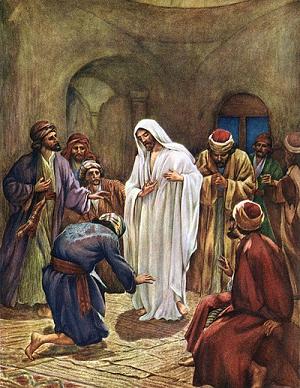
Paintings like this which span the two thousand year long history of Christianity, reinforce again and again that the disciples of Jesus were male only. Images such as this would have been more accurate if they had included women.
The Pistis Sophia is an early Christian text believed to have been written as early as the 2nd century AD but only discovered in 1773, after it was suppressed by the Church. It contains incredibly esoteric and complex teachings given to the disciples by the resurrected Jesus. In it, the female plays a central role: the Mother goddess is given various titles and her role in the universe is described, particularly as the Virgin of Light who judges the soul after death; Jesus discourses extensively throughout the text with a number of female disciples, such as Mary Magdalene, his mother Mary, Martha and Salome; and Mary Magdalene stands out as perhaps the most vocal and advanced of the disciples, taking part with the men just as other women disciples in the various esoteric discussions and mystic rites throughout the text (so much so that Peter actually complains to Jesus that she is taking too much time from the men!).
Mary, thou blessed one, whom I will perfect in all mysteries of those of the height, discourse in openness, thou, whose heart is raised to the kingdom of heaven more than all they brethren.
~ Jesus to Mary Magdalene in the Pistis Sophia, translated by G. R. S. Mead
It came to pass when Mary had finished saying these words, that the Saviour was greatly astonished at the definition of the words which she spoke, for she had become pure spirit utterly.
~ reference to Mary Magdalene in the Pistis Sophia, translated by G. R. S. MeadOn this account I have said to you aforetime: ‘Where I shall be there will be also my twelve ministers.’ But Mary Magdalene and John, the virgin, will tower over all my disciples and over all men who shall receive the mysteries in the Ineffable. And they will be on my right and on my left. And I am they and they are I.
~ Jesus, the Pistis Sophia, translated by G. R. S. MeadMary, hast received form which is in Barbelo, according to matter, and hast received likeness which is in the Virgin of Light, according to light, thou and the other Mary, the blessed one; and on thy account darkness hath arisen, and moreover out of thee did come forth the material body in which I am…
~ Jesus describes to his mother Mary in the Pistis Sophia how she has the likeness of the Virgin of Light, the Mother of the universe, as this is what she symbolically represents and who gives us our body, translated by G. R. S. Mead
It came to pass then, when the First Mystery had finished speaking these words unto the disciples, that Mary came forward and said: “My Lord, my mind is ever understanding, at every time to come forward and set forth the solution of the words which she hath uttered; but I am afraid of Peter, because he threatened me and hateth our sex.”
And when she had said this, the First Mystery said unto her: “Every one who shall be filled with the spirit of light to come forward and set forth the solution of what I say,–no one shall be able to prevent him. Now, therefore, O Mary, set forth then the solution of the words which Pistis Sophia hath uttered.”
~ Mary Magdalene to Jesus in the Pistis Sophia, translated by G. R. S. MeadMy Lord, we will not endure this woman, for she taketh the opportunity from us and hath let none of us speak, but she discourseth many times.
~ Peter complains about Mary Magdalene to Jesus in the Pistis Sophia, translated by G. R. S. Mead
Also in the Pistis Sophia, the disciples read from another text called The Odes of Solomon, which they repeatedly quote from. This text can still be read today as it was rediscovered in 1909. It is yet another early Christian text that refers to the Holy Spirit as female.
The Son is the cup, and the Father is He who was milked; and the Holy Spirit is She who milked Him…
~ The Odes of Solomon, translated by James H. CharlesworthThe dove fluttered over the head of our Lord Messiah, because He was her head. And she sang over Him, and her voice was heard.
~ The Odes of Solomon, translated by James H. CharlesworthI rested on the Spirit of the Lord, and She lifted me up to heaven;
And caused me to stand on my feet in the Lord’s high place, before His perfection and His glory, where I continued glorifying Him by the composition of His Odes.
The Spirit brought me forth before the Lord’s face, and because I was the Son of Man, I was named the Light, the Son of God;
Because I was the most glorified among the glorious ones, and the greatest among the great ones.
For according to the greatness of the Most High, so She made me; and according to His newness He renewed me.
~ The Odes of Solomon, translated by James H. Charlesworth
Women and the Mother in The Acts of Thomas
The Acts of Thomas is a 3rd century text that was rejected by mainstream Christianity, and was officially labeled as heretical by the Catholic Church. It was written in Syria where it’s likely the arm of the Church could not fully extend to wipe out the original teachings of Jesus and the disciples on women and the Mother. It follows the mission of Judas Thomas to give the teaching in India, and contains references of equality toward women, the Mother in Godhead, and to the Holy Spirit as female.
Come, thou holy name of the Christ that is above every name.
[…] we glorify and praise thee and thine invisible Father and thine holy spirit [and] the mother of all creation.
Come, thou power of the Most High, and the compassion that is perfect.
Come, gift (charism) of the Most High.
Come, compassionate mother.
Come, communion of the male.
Come, she that revealeth the hidden mysteries.
Come, mother of the seven houses, that thy rest may be in the eighth house.
Come, elder of the five members, mind, thought, reflection, consideration, reason; communicate with these young men.
Come, holy spirit, and cleanse their reins and their heart, and give them the added seal, in the name of the Father and Son and Holy Ghost.
~ The Acts of Thomas, translated by M. R. James
~ The Acts of Thomas, translated by M. R. JamesAnd he began to say: Come, O perfect compassion, Come O communion of the male, Come, she that knoweth the mysteries of him that is chosen, Come, she that hath part in all the combats of the noble champion (athlete), Come, the silence that revealeth the great things of the whole greatness, Come, she that manifesteth the hidden things and maketh the unspeakable things plain, the holy dove that beareth the twin young, Come, the hidden mother, Come, she that is manifest in her deeds and giveth joy and rest unto them that are joined unto her: Come and communicate with us in this eucharist which we celebrate in thy name and in the love-feast wherein we are gathered together at thy calling. (Syr. has other clauses and not few variants.) And having so said he marked out the cross upon the bread, and brake it, and began to distribute it. And first he gave unto the woman, saying: This shall be unto thee for remission of sins and eternal transgressions (Syr. and for the everlasting resurrection). And after her he gave unto all the others also which had received the seal (Syr. and said to them: Let this eucharist be unto you for life and rest, and not for judgement and vengeance. And they said, Amen. Cf. 29 fin.).
~ The Acts of Thomas, translated by M. R. JamesBread of life, the which who eat abide incorruptible: Bread that filleth the hungry souls with the blessing thereof: thou art he that vouchsafest to receive a gift, that thou mayest become unto us remission of sins, and that they who eat thee may become immortal: we invoke upon thee the name of the mother, of the unspeakable mystery of the hidden powers and authorities (? we name the name of the unspeakable mystery, that is hidden from all &c.).
~ The Acts of Thomas, translated by M. R. JamesAnd they have glorified and praised with the living spirit, the Father of truth and the mother of wisdom.
~ The Acts of Thomas, translated by M. R. JamesFrom Us – King of Kings, thy Father,
And thy Mother, Queen of the Dawn-land,And from Our Second, thy Brother –
To thee, Son, down in Egypt, Our Greeting!Up an arise from thy sleep,
Give ear to the words of Our Letter!Remember that thou art a King’s son;
See whom thou hast served in thy slavedom.Bethink thyself of the Pearl
For which thou didst journey to Egypt.
~ From the Hymn of the Pearl in The Acts of Thomas, translated by G. R. S. Mead
The Mother Included as Part of the Holy Trinity in the Gospel of the Egyptians
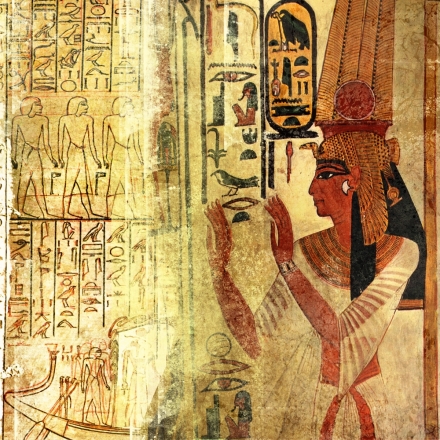
The Gospel of the Egyptians doesn’t mix words about the Mother being part of the Trinity. She’s not alluded to as the Holy Spirit, but is simply called “the Mother”.
Three powers came forth from him; they are the Father, the Mother, (and) the Son, from the living silence, what came forth from the incorruptible Father. These came forth from the silence of the unknown Father…
From that place, the three powers came forth, the three ogdoads that the Father brings forth in silence with his providence, from his bosom, i.e., the Father, the Mother, (and) the Son.
The <first> ogdoad, because of which the thrice-male child came forth, which is the thought, and the word, and the incorruption, and the eternal life, the will, the mind, and the foreknowledge, the androgynous Father.
The second ogdoad-power, the Mother, the virginal Barbelon, epititioch[…]ai, memeneaimen[…], who presides over the heaven, karb[…], the uninterpretable power, the ineffable Mother. She originated from herself […]; she came forth; she agreed with the Father of the silent silence.
The third ogdoad-power, the Son of the silent silence, and the crown of the silent silence, and the glory of the Father, and the virtue of the Mother, he brings forth from the bosom the seven powers of the great light of the seven voices. And the word is their completion.
~The Gospel of the Egyptians from the Nag Hammadi Library, translated by Alexander Bohlig and Frederik WisseThen the child of the child, Esephech, appeared.
And thus he was completed, namely, the Father, the Mother, the Son, the five seals, the unconquerable power which is the great Christ of all the incorruptible ones.
~The Gospel of the Egyptians from the Nag Hammadi Library, translated by Alexander Bohlig and Frederik Wisse
In the excerpts above, the Father is said to be androgynous. This is because the Father, or masculine aspect of the creator, only becomes masculine as a result of being separated from the Mother, the feminine aspect of the creator. Until then, the supreme creator is neither male nor female, but contains the attributes of both. The creator divides into male and female (which is also why in the excerpt that the Mother originated from herself, as she is not born, but is an aspect of God that already exists), in order to begin creation, which results in the birth of the Son, and the formation of what is known as the Trinity.
The Feminine as Essential to Creation in Ancient Spiritual Teachings
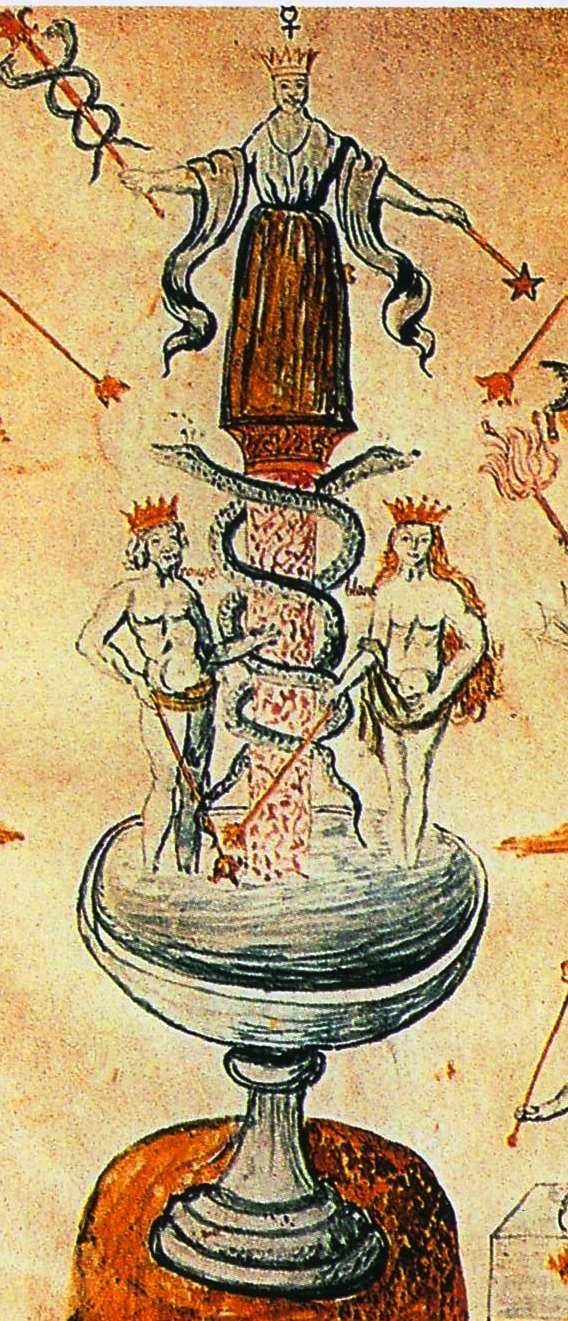
In this medieval illustration of alchemy, the union of man and woman creates the spiritual – both are needed. The grail symbolizes the female sexual organs, and the lingam the male sexual organs. Likewise nature and the divine cosmic process of creation follow the same principles, which was coined by the phrase “as above, so below”.
It is clear from even just the few examples given in the texts suppressed by the Church above, that there was a very different spirituality taught by Jesus and practiced by those who wrote these texts. It is one that is very different from the popular version of Christianity founded largely on the Old Testament and the teachings of Paul, and instead shares more in common with some of the most ancient, sacred, and revered spiritual teachings known to humankind from throughout the world – revealing its truly universal nature.
The accounts of the creation from ancient sources, including Essene, early Christian, Egyptian, Chinese, Incan, Hindu, and Vedic, tend to be based on the same fundamental principles. In their descriptions and symbols, a masculine and feminine force unite to give birth to a divine child or Son, and the entirety of creation.
Creation from Out of Unity
In these accounts, the male and female forces that create the universe originate as dual aspects of a supreme, androgynous, and self-manifest creator.
In Egyptian creation accounts, this supreme creator was called Atum – described as the Being of the Being and “the Great He-She”. Atum created the first gods – they were life, who was a male god known as “Shu”, and order, a female goddess known as “Tufnut”. Likewise in ancient Vedic accounts, the unknowable and genderless Brahman creates through the female Prakriti (matter), and male Purusha (spirit). And in ancient China it was said that the great unknowable and unnameable Tao gave rise to yin energy (which is feminine) and yang energy (which is masculine) and that these energies formed the basis of all creation.
“The Tao gives birth to One. One gives birth to yin and yang. Yin and yang give birth to all things.”
~ Hua Hu Ching, translated by Brian Walker
Division into Duality
This division of God into the duality of energy, polarized as masculine and feminine, allows creation to form, as in unity only one exists – but creation results from division into multiplicity. This can be understood through mathematics. 0 becomes manifest only once it becomes 1. 1 halved becomes 2. Each 1 gives half of itself, just as parents each contribute to half of the chromosomes that creates a newborn child, and thus 2 now becomes 3, and the unfolding of the vast geometric patterns and mathematical equations that underlie the universe begins.
It is not possible for a male to be created alone and exist alone as half of duality, and then to bring forth a female out of themselves – as something is only male by virtue of it being separated from the female. Instead, male and female both contain what the other lacks, and this forms the basis of their mutual attraction – with each craving what they are missing and finding it in the other, just like two oppositely charged magnets. This is why male and female are always found together throughout nature, and their loving unity creates a sense of completeness.
This duality is what defines our entire universe, which is based on polarity, with each opposite extreme defining the outer limit of all that exists. Our whole universe is contained within the limits of light and dark, hot and cold, dry and wet, male and female, positive and negative, etc. Each opposite property is associated with either masculinity or femininity – and at their root, masculinity and femininity are the same source energy polarized in the inverse, which gives our universe and all beings their dual properties.
Whilst in orthodox Judaeo-Christianity (as well as many other religions) the feminine became an object of suspicion, superstition, taboo, and suppression, it is self evident that femininity plays an absolutely essential role in the created, natural world and ironically is half of the creative Godhead, which these religions so devoutly claim to worship.
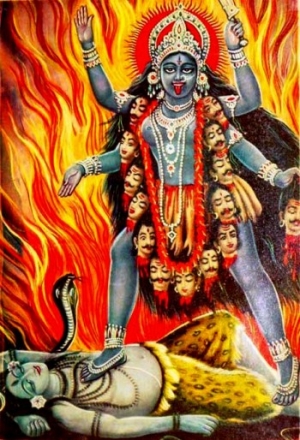
A painting of the Hindu goddess Kali representing the transformative power of feminine energy, standing on the god Shiva, who represents the constancy and stability of masculine energy – both in complement to the other. These images of divine femininity contrast sharply with images of women in Christianity.
In ancient Hinduism, the feminine aspect of Godhead is sometimes referred to as Shakti. The descriptions of these goddesses give some idea of how immense and essential the feminine is to all of creation.
From Wikipedia:
“The primordial feminine creative-preservative-destructive energy, Shakti, is considered to be the motive force behind all action and existence in the phenomenal cosmos. The cosmos itself is Shiva or Purusha, the unchanging, infinite, immanent, and transcendent reality that is the Divine Ground of all being, the “world soul”. This masculine potential is actualized by feminine dynamism, embodied in multitudinous goddesses who are ultimately all manifestations of the One Great Mother. Mother Maya or Shakti, herself, can free the individual from demons of ego, ignorance, and desire that bind the soul in maya (illusion).”
From Duality to Trinity
From duality comes trinity, as masculine and feminine energies give birth to child. Repeatedly, we see the same trinity of Father, Mother and Son depicted in the sacred teachings of the ancient world, such as in Joseph, Mary, and Jesus, and Osiris, Isis, and Horus. These trinities are symbolic of the fundamental forces that give rise to, sustain, and underlie the entirety of creation. In the structure of an atom these forces exist as protons (positive force, Father), electrons (negative force, Mother), and neutrons (neutral force, Son).
The Feminine as Manifest Nature
In ancient China the feminine was symbolized as a dragon, which was described as a creature capable of infinite transformation. In nature, we see transformation continuously taking place, which has its root in the dynamic fluctuations of electrons and their influence upon the form and structure of matter. In ancient religions, the feminine is associated with the cycles of nature and the cosmos, and of all that is transitory and impermanent in creation, which is why in Hinduism she was described as Maya – as that which is illusory and passing. This indicates that feminine energy is the basis of all manifest nature, found expressed on a microcosmic scale in the dynamic cycling of electrons (feminine) around the stable nucleus of protons (masculine) in atoms, and on a macrocosmic level in the cycling of the earth around the sun, the changing of the seasons, the waxing and waning of the moon, and even greater galactic and stellar cycles etc. Whereas masculinity is associated with what is constant and unchanging. Both the permanent and the temporal are aspects of creation and the creator, and both are necessary for life and awakening.
The Mother as Divine Cosmic Order
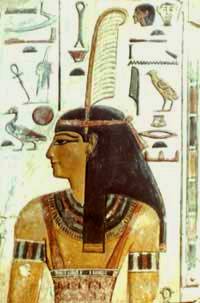
The beautiful Egyptian goddess Maat, embodiment of cosmic order, with her white feather of truth
In ancient Egypt, the counterpart of the first male god was the female Tefnut, who was order where the male was life. This cosmic order was personified as the beautiful goddess Maat holding a scepter of power in one hand and the key to eternal life in the other. She set the order of the universe from out of chaos from the first moment of creation. She embodied truth, harmony, balance, justice, law, wisdom and ethics; she was the natural order of all life in physical and spiritual realms; and regulated the cycles of the stars and seasons, and the actions of both humans and deities. In the ancient Egyptian view of life, one had to strive to fulfill the laws of Maat knowing at death their heart would be weighed by the deity Anubis on Maat’s scales against her white feather of truth.
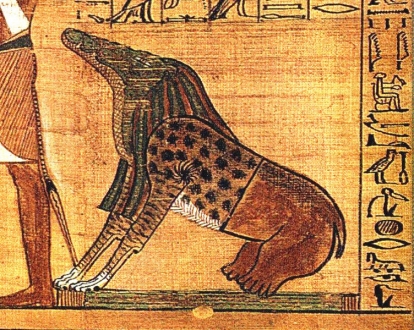
The Egyptian goddess Ammit – part crocodile, part lion, and part hippopotamus, and terrifying punisher of the dead.
If one fulfilled the laws of the Mother, they would be allowed to pass into paradise—the realm of eternal life (known as the “Kingdom of Heaven” of the Father), but for those who didn’t, the terrifying goddess Ammit—part crocodile, part lion, and part hippopotamus—waited beneath the scales to devour the heart that was heavier than the feather. The jaws of this crocodile can be seen in the spiritual realms (both in near-death and out-of-body experiences) as the entrance to what the Egyptians called, “the Place of Annihilation” and of “dying a second time”. This is “the mouth of hell”, the entrance to the Abyss, where the egos of the dead are destroyed through punishment and suffering.
In the goddesses Maat and Ammit, we see the representations of the Mother as cosmic law, order, and punishment—she in whom all life and death is contained, like the mother who bears us, who rears us, teaching us about the order of life and the universe, and chastising us when we violate this order. She teaches through the realms of nature, in human life, and also through hell where beings learn through just punishment. This had its influence on Egyptian society, as the advice of women oracles guided the rulers of Egypt. Likewise in ancient Greece, the female Delphic priestess and oracle was the highest authority even in its male dominated society.
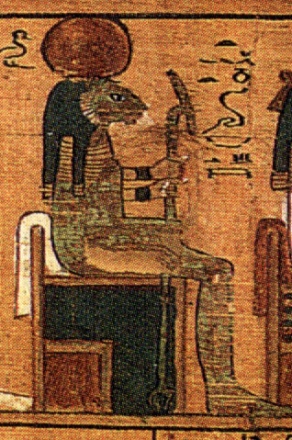
The Egyptian goddess Tefnut presiding over the weighing of the heart of the dead against her laws as part of their judgement. She has the face of a lion and holds the scepter of power.
In ancient esoteric Christianity, Jesus also identifies the Mother as the judge and punisher of the soul, just as the Egyptians did. In the Pistis Sophia, Jesus explains how the soul is judged by “the judge” who is the “Virgin of Light”, and who is female. He describes how the Mother assesses the spiritual work of the individual soul and also its sin, and based upon what it has done, assigns it its fate, which includes punishment in hell, heaven, or rebirth into another body according to its deeds (karma).
…the counterfeiting spirit leadeth the soul to the Virgin of Light, the judge; and the judge, the Virgin of Light, proveth the soul and findeth that it hath sinned and, as she also hath not found the mysteries of the Light with it, she handeth it over to one of her receivers, and her receiver leadeth it and casteth it into the body, and it cometh not out of the changes of the body before it hath yielded its last circuit.
~ Jesus, Pistis Sophia, translated by G. R. S. Mead
The Egyptian goddess Tefnut, the first female created as cosmic order, was depicted as a lion headed goddess, similar to the representations of the goddess Senge Dongma in Buddhism who is another lion headed goddess created to protect the world from demons, to Durga in Hinduism who rides astride a tiger as a fierce warrior and protector against evil, and to the ancient Sumerian goddess Inanna whose chariot was pulled by lions and was often depicted as a lioness in battle. Inanna was said to hold “full power of judgment and decision and the control of the law of heaven and earth.”
In the Jewish text The Wisdom of Solomon, the female aspect of Godhead is also seen as the law and order of creation, just as the ancient goddesses of Egypt.
For the very true beginning of her is the desire of discipline; and the care of discipline is love; And love is the keeping of her laws; and the giving heed unto her laws is the assurance of incorruption; And incorruption maketh us near unto God: Therefore the desire of wisdom bringeth to a kingdom.
~ The Wisdom of Solomon, KJV
For God loveth none but him that dwelleth with wisdom. For she is more beautiful than the sun, and above all the order of stars: being compared with the light, she is found before it. For after this cometh night: but vice shall not prevail against wisdom. Wisdom reacheth from one end to another mightily: and sweetly doth she order all things.
~ The Wisdom of Solomon, KJV
A Description of the Mother from the Essene Gospel of Peace
The following excerpt from The Essene Gospel of Peace beautifully summarizes the Mother as she who gives us life, who rules over us with her laws, in whom everything exists, and who heals us and protects us from all evil, as so many goddesses around the world have depicted.
The Incan Mother goddess Pachamama
Your Mother is in you, and you in her. She bore you she gives you life. It was she who gave to you your body, and to her shall you one day give it back again. Happy are you when you come to know her and her kingdom; if you receive your Mother’s angels and if you do her laws. I tell you truly, he who does these things shall never see disease. For the power of our Mother is above all. And it destroys Satan and his kingdom, and has rule over all your bodies and all living things.
The blood which runs in us is born of the blood of our Earthly Mother. Her blood falls from the clouds; leaps from the womb of the earth; babbles in the brooks of the mountains; flows wide in the rivers of the plains; sleeps in the lakes; rages mightily in tempestuous seas.
The air which we breathe is born of the breath of our Earthly Mother. Her breath is azure in the heights of the heavens; soughs in the tops of the mountains; whispers the leaves of the forest; billows over the cornfields; slumbers in the deep valleys, burns hot in the desert.
The hardness of our bones is born of the bones of our Earthly Mother, of the rocks and of the stones. They stand naked to the heavens on the tops of mountains; are as giants that lie sleeping on the sides of the mountains, as idols set in the desert, and are hidden in the deepness of the earth.
The tenderness of our flesh is born of the flesh of our Earthly Mother; whose flesh waxes yellow and red in the fruits of the trees, and nurtures us in the furrows of the fields.
Our bowels are born of the bowels of our Earthly Mother, and are hid from our eyes, like the invisible depths of the earth.
The light of our eyes, the hearing of our ears, both are born of the colors and the sounds of our Earthly Mother; which enclose us about, as the waves of the sea a fish, as the eddying air a bird.
I tell you in very truth, Man is the Son of the Earthly Mother, and from her did the Son of Man receive his whole body, even as the body of the newborn babe is born of the womb of his mother. I tell you truly, you are one with the Earthly Mother; she is in you, and you in her. Of her were you born, in her do you live, and to her shall you return again. Keep, therefore, her laws, for none can live long, neither be happy, but he who honors his Earthly Mother and does her laws. For your breath is her breath; your blood her blood; your bone her bone; your flesh her flesh; your bowels her bowels; your eyes and your ears are her eyes and her ears.
I tell you truly, should you fail to keep but one only of all these laws, should you harm but one only of all your body’s members, you shall be utterly lost in your grievous sickness, and there shall be weeping and gnashing of teeth. I tell you, unless you follow the laws of your Mother, you can in no wise escape death. And he who clings to the laws of his Mother, to him shall his Mother cling also. She shall heal all his plagues, and he shall never become sick. She gives him long life, and protects him from all afflictions; from fire, from water, from the bite of venomous serpents. For your Mother bore you, keeps life within you. She has given you her body, and none but she heals you. Happy is he who loves his Mother and lies quietly in her bosom. For your Mother loves you, even when you turn away from her. And how much more shall she love you, if you turn to her again? I tell you truly, very great is her love, greater than the greatest of mountains, deeper than the deepest seas. And those who love their Mother, she never deserts them. As the hen protects her chickens, as the lioness her cubs, as the mother her newborn babe, so does the Earthly Mother protect the Son of Man from all danger and from all evils.
~ The Essene Gospel of Peace, translated by Edmund Bordeaux Szekely
The Mother as Personal to Us In the Spiritual Work of Enlightenment
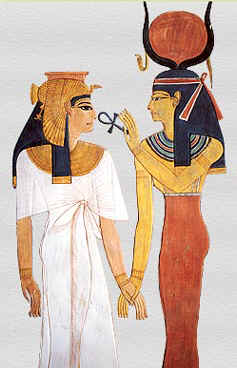
Isis feeding the Ankh of eternal life to an Egyptian Queen.
Just as there is a feminine aspect of the creator, so too is there a feminine aspect of consciousness.
The process of creation follows the same principles and patterns from the macrocosmic level, right down to the mircocosmic (as we live in a fractal, holographic universe where the same fundamental pattern appears at all scales, and the wholeness is found everywhere and in everything), whether it is in the creation of life in the natural world, in the creation of the universe, and even in the creation of our consciousness. Everything is born from the union of male and female energies. This is why in sacred teachings a maxim of wisdom is “as above, so below”.
“Within the great cosmic process, the two ch’I — Ch’ien the father and K’un the mother — blend harmoniously and give birth to all creation. Therefore, it is said that in all creation only man is also thus. Man possesses a prenatal and postnatal nature. The prenatal is the spiritual father and divine mother; the postnatal is the mundane father and mundane mother.”
~ The True Transmission of the Golden Elixir, translated by Douglas Wile
Just as in the process of the creation of the universe, described by many ancient sacred teachings, creation starts from the androgynous and unknowable being, so too do we as consciousness. Our consciousness must then divide into duality in order to manifest into creation. This division results in masculine and feminine aspects of our higher consciousness, symbolized as Father and Mother – who are two parts of the same whole.
In the spiritual work, all the aspects of our consciousness are reunited and made whole again and we return to the source as one, just as we first left, but having learnt and awakened through the experience of separation and duality.
Jesus said to them, “When you make the two one, and when you make the inside like the outside and the outside like the inside, and the above like the below, and when you make the male and the female one and the same, so that the male not be male nor the female female; and when you fashion eyes in the place of an eye, and a hand in place of a hand, and a foot in place of a foot, and a likeness in place of a likeness; then will you enter the kingdom.”
~ Jesus, The Gospel of Thomas, translated by Thomas O. Lambdin
The Mother Goddess and the Feminine in Spirituality

The male and female aspects of Godhead, both venerated in ancient Egypt (photo CC BY-SA 3.0 by Bernard Gagnon, edited).
Although ancient texts can provide us with an incredible source of guidance, they are often written within the social framework of the time and can be tampered with by uncomprehending and even sinister hands. The conventional Church suppressed the true understanding of the Mother not only in Christianity, but in their oppression of earlier pagan religions, in which the Mother and feminine were venerated.
Thankfully the principles of life and spirituality are found in ourselves and all of creation, allowing the individual to find their way back to the source – free of the dogmas and constraints of religions that become based on beliefs rather than living experience and perception. Holding a blind belief in something is how a commitment to the most absurd ideas can take precedence over a perception of undeniable truths that are right in front of us.
Many women have suffered an injustice by being placed under a dogma which reinforced the use of male aggression to subdue women who are naturally physically weaker. And in doing so these parts of the world lost touch with the Mother and the liberated creativity of the feminine, creating places and periods of darkness and suppression.
Returning to the understanding of cosmic principles, and guided by universal laws such as “As above, so below”, it becomes apparent that Mother and Father, male and female forces, always bring forth creation together in equality, and therefore men and women exist in equality according to the same cosmic principles, with neither able to create without the other.
As many who have had out-of-body experiences and near-death experiences can attest, there are awakened females who exist in higher dimensions to help us here to learn and awaken, and in accounts of extraterrestrial encounters, female extraterrestrials are just as present as males – having pioneered the vast reaches of the cosmos (without being confined to the kitchen!). This shows that despite the artificial constructs of our earthly societies and religions, women have the same rights to pursue their destiny as they wish, and the same potential to awaken the spiritual within. Women have the same innate rights of self-determination as men, and can lead, organize, and gather, just as men have the right to in both the spheres of society and religion.
In reality, the Mother is all around us, and inside each one of us ready to help us walk the path of the sun through her transformative power. If as a society we can recognize the feminine in her rightful place, as an essential part of creation, then we as a humanity have a much greater opportunity to appreciate the potential of the feminine in our lives and to end the injustice against it – instead creating a world based not on dogma, but on the eternal cosmic principles that permeate and guide our universe.
The valley spirit never dies;
It is the woman, primal mother.
Her gateway is the root of heaven and earth.
It is like a veil barely seen.
Use it; it will never fail.
~ Lao Tzu from The Tao Te Ching, translated by Gia-Fu Feng and Jane English
Everyone else is busy,
But I alone am aimless and without desire.
I am different.
I am nourished by the great mother.
~ Lao Tzu from The Tao Te Ching, translated by Gia-Fu Feng and Jane EnglishThe beginning of the universe
Is the mother of all things.
Knowing the mother, you also know the sons.
Knowing the sons, yet remaining in touch with the mother,
Brings freedom from the fear of death.
~ Lao Tsu from The Tao Te Ching, translated by Gia-Fu Feng and Jane English
~ Copyright 2012 by Mark and Lara Atwood
Please note that whilst I, Lara, wrote the article and did the research into sacred texts, the esoteric knowledge was provided entirely by Mark and can be explored further in his works and writings.

Here are some songs about the Mother, which convey in some way her immense and incredible nature:
Ancient Mother by Robert Gass & On Wings of Song

Lady of the Flowing Waters by Robert Gass & On Wings of Song


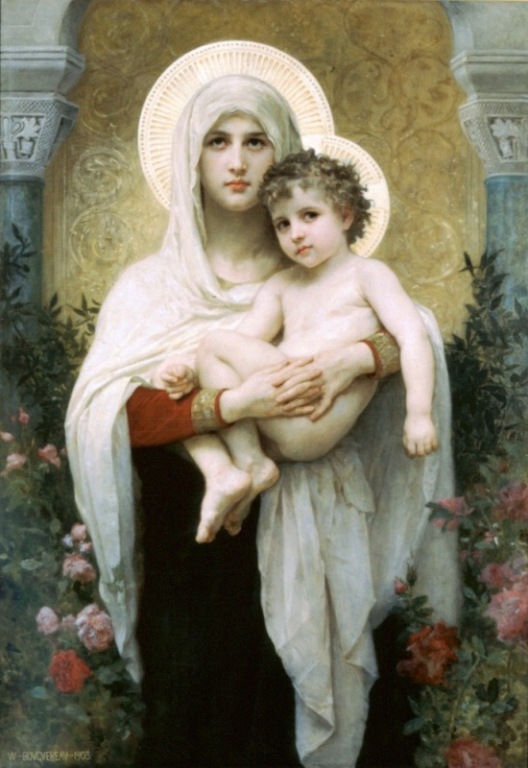 In everything that is life is the law written. You find it in the grass, in the tree, in the river, in the mountain, in the birds of heaven, in the fishes of the sea; but seek it chiefly in yourselves. For I tell you truly, all living things are nearer to God than the scripture which is without life. God so made life and all living things that they might by the everlasting word teach the laws of the true God to man. God wrote not the laws in the pages of books, but in your heart and in your spirit. They are in your breath, your blood, your bone; in your flesh, your bowels, your eyes, your ears, and in every little part of your body. They are present in the air, in the water, in the earth, in the plants, in the sunbeams, in the depths and in the heights. They all speak to you that you may understand the tongue and the will of the living God. But you shut your eyes that you may not see, and you shut your ears that you may not hear. I tell you truly, that the scripture is the work of man, but life and all its hosts are the work of our God. Wherefore do you not listen to the words of God which are written in His works? And wherefore do you study the dead scriptures which are the work of the hands of men?
In everything that is life is the law written. You find it in the grass, in the tree, in the river, in the mountain, in the birds of heaven, in the fishes of the sea; but seek it chiefly in yourselves. For I tell you truly, all living things are nearer to God than the scripture which is without life. God so made life and all living things that they might by the everlasting word teach the laws of the true God to man. God wrote not the laws in the pages of books, but in your heart and in your spirit. They are in your breath, your blood, your bone; in your flesh, your bowels, your eyes, your ears, and in every little part of your body. They are present in the air, in the water, in the earth, in the plants, in the sunbeams, in the depths and in the heights. They all speak to you that you may understand the tongue and the will of the living God. But you shut your eyes that you may not see, and you shut your ears that you may not hear. I tell you truly, that the scripture is the work of man, but life and all its hosts are the work of our God. Wherefore do you not listen to the words of God which are written in His works? And wherefore do you study the dead scriptures which are the work of the hands of men?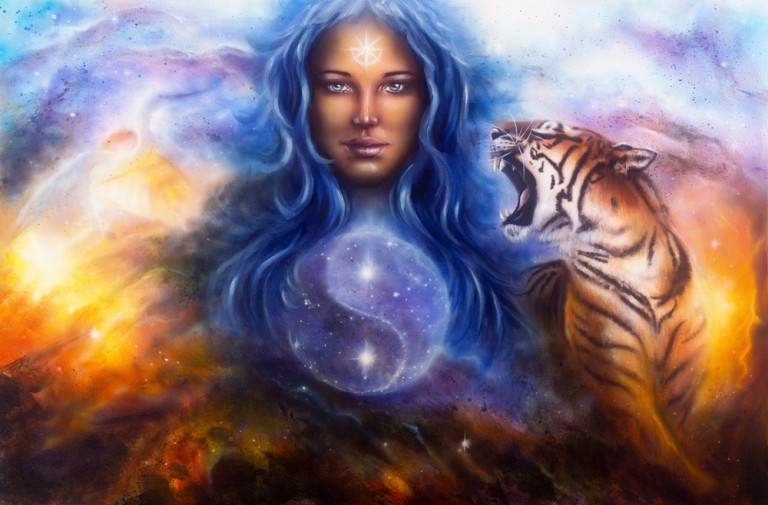

Did you speak on sun goddesses or the solar feminine in your books? From the blurbs and looking over the site, I only see the common Western bias agenda of the “solar masculine and lunar or earth feminine.”
Hi Andrea,
What might seem like a Western bias toward a masculine sun god at a cursory look, is actually based on very ancient beliefs that were central to an ancient Religion of the Sun that spread around the world.
I’ll give you a few examples:
Based on the archeology and folklore, I think it’s clear that the builders of the Neolithic passage mounds of Ireland believed in a masculine god of light/the sun, who impregnated a feminine Earth goddess (whose womb is symbolized by the mound), and gave birth to a solar son. The ancient site of Newgrange is the clearest example of this belief.
In ancient Egypt the sun was seen as the god Ra, though many gods and goddesses were depicted with the sun disk atop their heads to indicate their divine status. Those who spiritually resurrected were identified with the sun, whether man or woman.
In India, in Vedic times, the sun was central. The ultimate, genderless creator was believed to be manifest as the sun, and was called Brahman. Essentially all the gods were seen as having a solar nature. Though there was also a very old Indo-European belief in the highest god Dyaus Pitar (literally, “sky father”, whose eye was the sun) and his wife the great earth Mother goddess Prithvi. There were many names given to the sun god, but the one that seems to have stuck is Surya.
Then there is the Taoist belief of China in yin (feminine) and yang (masculine). The sun is seen as a manifestation of yang energy, while the earth that of yin.
There are beliefs in a feminine sun goddess, like in Norse and Japanese cultures, though these are fewer, and I argue, seem to be derived from more ancient beliefs in which there were both male and female deities that were associated with the sun.
So you see, it’s not as straight forward as their being a Western bias.
I personally believe that the sun (and stars) is the highest physical expression of the divine, and that both men and women can give birth to this divine light within themselves, and that without male and female, this birth would not be possible as they each play an equally important role.
The information is vital.Can Vatican comment?